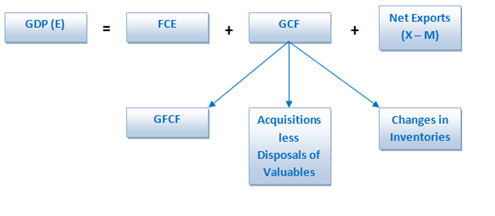1. Introduction
Non-monetary gold (NMG) is an erratic series that is a component of trade in goods and services; it also appears within gross capital formation (GCF) as valuables . There have been some large revisions to this series recently. This note explains why neither the erratic path of NMG nor revisions to trade in NMG have an impact on gross domestic product (GDP) – the effect is GDP neutral.
Nôl i'r tabl cynnwys2. What is non-monetary gold?
Gold may be held as a reserve asset by a monetary authority. If so, this gold is classified as monetary gold and is recorded in the Financial Account. However, others may hold gold such as jewellery as a store of wealth. Gold that is not held as a reserve asset by a monetary authority is classified as NMG. When NMG is held in an allocated account, full legal ownership of the physical gold itself is given to the account owner. In this instance, transactions with non-residents involving the sale or purchase of gold feed into trade in goods or valuables. Gold traded between UK residents does not appear in trade or changes in valuables.
Trade in NMG (that is, gold bullion, gold coin, unwrought or semi-manufactured gold and scrap) is included within the erratic component of UK net exports (Exports (X) minus Imports (M)). Whereas, trade in finished manufactures of gold (for example, jewellery) are included elsewhere in net exports as trade in goods.
Nôl i'r tabl cynnwys3. Acquisitions less disposals of valuables
Acquisitions less disposals of valuables are non-financial assets that are not used up in production or consumption, do not deteriorate (physically) over time under normal conditions, and are acquired and held primarily as stores of value in the expectation that their value will increase over time. Valuables consist of works of art, precious metals (including non-monetary gold), and stones and articles of jewellery fashioned out of said materials.
Nôl i'r tabl cynnwys4. GDP neutrality
Trade in existing non-monetary gold (gold which is already being held as a valuable) tends to be a very volatile series despite being smoothed via a moving average. This trade in NMG is GDP neutral (not impacting GDP) as explained through the mechanisms shown in figure 1. It should be noted that, while the trade of existing NMG itself is GDP neutral, there are separate costs of ownership transfer on valuables which are treated as intermediate consumption in the national accounts.
The neutrality of GDP in national accounts

Source: Office for National Statistics
Download this image The neutrality of GDP in national accounts
.png (24.8 kB)The expenditure method of measuring GDP (GDP (E)) is made up of final consumption expenditure (FCE), GCF and net exports. GCF is subdivided into gross fixed capital formation (GFCF), acquisitions less disposals of valuables, and changes in inventories.
Within this method of calculating GDP (E), exports of NMG have a positive impact on net exports whilst imports have a negative impact. However, when NMG is exported there is a corresponding decrease in GCF (valuables) held within the UK; the opposite can be said for importing NMG. When NMG is imported there is a corresponding increase in GCF (valuables) held within the UK.
For example, suppose that a resident that is not a monetary authority purchases an amount of gold equivalent to £1 million and the gold is purchased from a foreign party. Imported gold is seen as an acquisition of a valuable as the gold enters the UK; however, £1 million is subtracted from GDP due to the import. As the value of the gold acquisition and the import cancel out, the net effect is a GDP neutral impact on UK GDP. The opposite can be said for exporting gold abroad; if £1 million worth of gold was sold to a foreign party then this is a disposal of gold equal to £1 million (a reduction in acquisitions less disposals of valuables of £1 million) yet £1 million is added to UK GDP via the transaction (an increase in net exports of £1 million).
Nôl i'r tabl cynnwys
